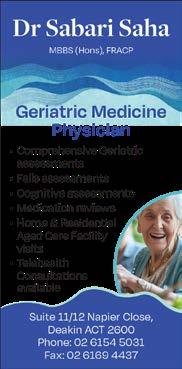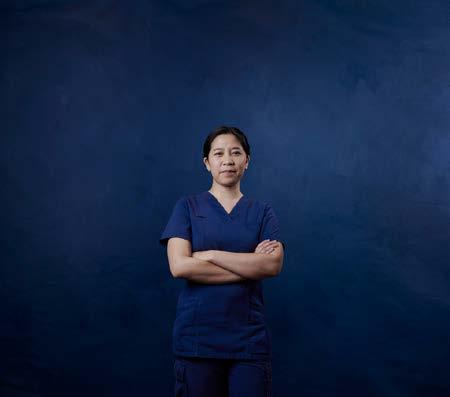CIRCULATION: 1,900 IN ACT & REGION

Meet the medical students
PAGES 6-8




Informing the Canberra medical community since 1988
A doctor's heart for Türkiye
PAGES 14-15

CIRCULATION: 1,900 IN ACT & REGION

PAGES 6-8




Informing the Canberra medical community since 1988
PAGES 14-15
An unprecedented hearing of the Fair Work Commission this month is set to resolve the intractable pay dispute between the ACT Government and public hospital doctors.
The full bench of the Commission will hear evidence from both sides of the debate over three days starting 3 March, before handing down a binding determination. At the heart of the dispute is medical practitioners' rates of pay, which have not increased for more than two years. Since bargaining began in 2022, AMA ACT has consistently called for wage increases of “CPI plus 1%” to preserve real earnings in an environment of high inflation and past modest wage increases.
This would mean pay rises for all doctors covered by the agreement of:
6.58% from 1 Jan 2023
(noting that a small increase was paid in June 2022);
5.45% from 1 Jan 2024;
3.62% from 1 Jan 2025; and 4.10% from 1 Jan 2026.
Mr Greg Schmidt, Senior Workplace Relation Advisor at AMA ACT provided evidence to the Commission detailing how each of the Government’s pay offers since 2022 have been below the rates of CPI in Canberra, and argued that “some form of catch up was in order”.
The Government’s wage offer has remained largely unchanged throughout the bargaining period – a mix of flat rate and percentage increases structured to give greater advantage to junior doctors. For example, the Government proposed pay rises that amounted to increases of just 3.7% annually for interns and 2.72% for senior specialists.


Unsurprisingly, doctors voted overwhelmingly to reject the Government’s offer in July.
Not since doctors strikes in the 1990s led to significantly improved conditions for VMOs

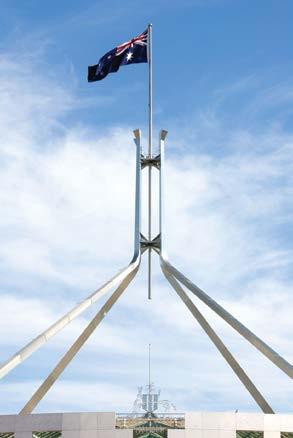
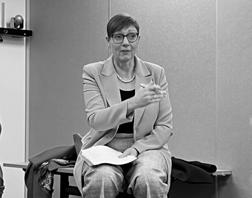
has the ACT seen such an intractable pay dispute between the ACT Government and public hospital doctors. Hundreds of ACT public hospital doctors participated in protected industrial action in October and November 2024, refusing to



participate in tasks that did not directly affect patient care.
When the ACT Government failed to respond with a better pay offer, the Australian Salaried Medical Officers Federation made an application to the Fair Work
Continued page 10
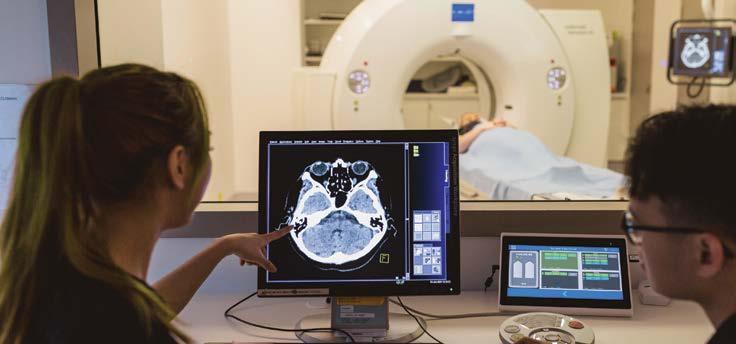

If ever there was a time for a strong, unified voice in medicine it’s now. On every front across our health system, doctors are facing challenges to clinical autonomy, scope and our capacity to care for patients.
Doctors are being asked to do more with less, whether it’s VMOs being forced off fee-for-service contracts, salaried doctors being denied fair pay rises year after year, or GPs being pressured to bulk-bill when Medicare won’t cover the costs of providing care.
All the while clinical autonomy is being increasingly eroded. How many of us have had to fight to have our patient management plans implemented, or just to have our referrals accepted – as if the rigours of medical training count for nothing?
If all this is bad for doctors, it’s even worse for patients. Because what happens when a health system stops listening to doctors? A large multicentre study in the Annals of Internal Medicine (Epub 2024 Nov 26) recently found doctors who felt they had inadequate control over factors such as patient load, team composition, clinical schedule, and workload were more likely to burn out and leave. In other words, you can’t treat doctors like garbage and expect they’ll stay. And yet, all the signs suggest that our health system is sliding further in this direction, becoming more like the dysfunctional health systems so many of our overseas-trained colleagues came here to escape.
Without a strong and unified voice of resistance, this is where we are headed. Be assured that AMA ACT is doing all we can to fight for you and your patients. We are grateful for the support of all our members and cannot do it without you.
AMA ACT has taken the rare step of investing tens of thousands of dollars in legal fees in our landmark campaign together with ASMOF ACT to achieve fairer pay and conditions for public hospital doctors, through the Fair Work Commission. We are optimistic that the Commission will find in favour of wage justice for salaried doctors when it hears the evidence in March, and are especially grateful to those doctors who have donated their time and shared their experiences as part of the AMA ACT’s case.
I have been on radio and television every week lately, talking about the issues that matter to you –whether it’s the public hospital funding cuts, the challenges faced by doctors-in-training or why we so desperately need to Modernise Medicare in line with AMA’s campaign (see page 11 for details). It’s so important for the public to have an awareness of what it is we doctors do – the complexity of modern medical practice, the administrative work that no one sees and no one pays for, the hundreds of phone calls between colleagues that keep patients off waiting lists, the rising costs of registration and
AMA ACT is closely watching to see where the axe falls for the ACT Government’s newly announced cost-cutting measures across Canberra Health Services.
Dr Kerrie Aust

insurance, and the evidencebased policies we need to bring sustainability to healthcare.
AMA ACT is closely watching to see where the axe falls for the ACT Government’s newly announced cost-cutting measures across Canberra Health Services. We are awaiting further details but are concerned lest restrictions leave patients with nowhere to go for some services, especially as some NSW hospitals are known to be turning away Canberra-based patients.
We are very concerned about the potential loss of clinical expertise and clinical supervision in some sections of Canberra Health Services as a result of the ACT Government’s announcement that it will not renew VMO fee-forservice contracts. Several VMOs have already told us they will leave. In spite of this kick, VMOs have been actively working to identify potential savings for the hospital. If we do see clinicians leave, as has been the case in other jurisdictions, there could be dire consequences for both patients who are sitting on the
wait list and the training and supervision of the next generation.
It’s exciting to see Federal Labor promising to invest in the GP workforce if re-elected, with salary incentives for junior doctors, paid parental leave for trainee GPs, and additional training places and rotations in general practice. This is great policy, in line with AMA’s Modernise Medicare campaign, and we’re pleased to see the Coalition also matching Labor’s pledge. However, the bulk-billing incentive they’re offering (an additional $20 per consult) is not enough to meet the cost of a private consult in the ACT. We therefore do not expect this announcement to cause significant change to bulk billing rates in the ACT. AMA wants to see fees restructured to support the complexity of general practice care, especially
NOT YET AN AMA MEMBER?
increased remuneration for longer consults, as outlined in our Modernise Medicare campaign.
Our regular Safe Space events are a great way to build a supportive medical community and develop habits to support a sustainable career. Our next event is Saturday 22 March, with speakers Dr Jill van Acker and Dr Marisa Magiros. See the AMA ACT website for more details or click on the following link https://www.trybooking.com/ CYZKY. Safe Space events are free to all local doctors and medical students and are hosted by AMA ACT together with Drs4Drs ACT. Finally, I want to say thank you to every doctor working so hard in our health system. We see the strain that you are under and thank you for the patient care, the advice on patient management and how you teach our next generation of doctors and medical students.
Scan the QR code to find out about joining.
Canberra Health Services’ capacity to continue offering some specialist services is under threat, as Visiting Medical Officers consider their response to the ACT Government’s plan to end fee-forservice contracts.
In the ACT public hospital system, Orthopaedics is essentially run by consultants working as VMOs, who supervise registrars in The Canberra Hospital’s highly-regarded Orthopaedics training program.
Likewise, CHS’s Vascular, Orthopaedics, Urology and Plastics departments rely heavily on fee-for-service VMOs.
These long-standing VMO arrangements are the result of a series of decisions made by an independent arbitrator over an extended period. The arbitrator has recognised the need to compensate VMOs for the highly skilled work they do.
Fee-for-service arrangements
facilitate consultants working efficiently, sometimes running multiple lists at once, as is the case in Orthopaedics.
However on January 29, CHS told VMO staff it would be
With immediate effect, no further fee for service contracts will be issued.
Email from Dr Grant Howard, 29 January.
moving away from fee-for-service contracts and would only offer them sessional contracts or employment as staff specialists. The move is part of a suite of cost-cutting measures to manage a cost blowout that saw the ACT Government need to invest an additional $227

million in the health system in its mid-year budget update.
VMOs say the decision has been imposed on them without consultation, and without due consideration of the unintended negative consequences. Several VMOs say they will cease offering their services to the public hospital sector altogether rather than accept a sessional contract or offer of salaried employment, raising questions about the sustainability of some departments and their training programs.
Paul Cooke often jokes that he is “almost” a doctor. A Financial Advisor with Parker Financial for around 15 years, Paul is surrounded by medical practitioners. His parents were General Practitioners in Temora and then Queanbeyan. His wife has been a GP in Yarralumla for over 30 years. Two of his adult children are freshly minted doctors and many of his friends are medical practitioners and clients - in Canberra, Sydney and Melbourne. It is no surprise that he has insight, knowledge and a special interest in the financial needs of the medical profession.


AMA ACT is working together with the ACT VMOA and different VMO specialist groups to find an outcome that ensures we can keep our highly skilled VMOs. CHS argues that other jurisdictions have already abandoned VMO fee-for-service contracts in favour of sessional rates or salaried positions, however AMA ACT notes that this is not the case for hospitals that struggle to compete for consultants in particular specialties. For instance, Blacktown and Campbelltown
Hospitals in NSW still offer VMO fee-for-service contracts. AMA ACT argues that these hospitals are more suitable comparators to CHS than metropolitan hospitals in Sydney or Melbourne. As part of its cost-cutting package, the ACT Government has also announced a freeze on recruitment of “non-frontline staff". AMA ACT is very concerned that this measure, together with the loss of some VMOs, could lead to excess workload on remaining hospital staff.
Below are some typical examples of the medical practitioners that Paul and the Parker team have helped over the years:
Dr A Hospital Registrar.
Dr B Radiologist.
Dr C General Surgeon.
Dr D Pathologist
Age 58. Recently Inherited a property and shares when a parent passed away. Wants to maximise balances in Self-Managed Superannuation Fund (SMSF) but not sure how and no longer has time/ interest to manage investments.
Dr E G.P.
Age 65. Owner of
Paul and the team of advisers at Parker Financial have developed a broad experience and niche set of skills in supporting doctor’s financial requirements at all stages of their professional and personal lives.
Contact either Paul, Sam or Patricia for a no obligation chat in relation to your situation. 02 6267 0700 www.parkerfinancial.com.au pcooke@parkerfinancial.com.au

Canberra Health Services is increasingly relying on International Medial Graduates to fill intern positions, as the number of ANU graduates accepting places slides.
Graduates of ANU’s School of Medicine and Psychology comprise only 50% of the 2025 intern cohort at CHS, down from 53% in 2024 and 62% in 2023.
While the intake of graduates from other Australian medical schools has remained relatively stable over the last three years, at 22-24%, the proportion of International Medical Graduates (IMGs) has been rising– comprising a record 28% of this year’s cohort.
The figures raise questions about whether CHS needs to do more to compete for junior doctors.
ANU medical school director, Professor Paul Fitzgerald, told Canberra Doctor: “Our graduates are highly sought after around the country and able to apply successfully for the most competitive hospitals in the country with outstanding post-graduate/ clinical training programs.
“Placements for interns have grown around the country so our graduates have more choice than they did in previous years.”
CHS confident in its approach
CHS says it has already been making large investments to support junior doctors, and is confident its approach is working.
It noted 85% of last year’s interns stayed on at CHS for 2025, compared with only 76% in 2024 – part of the reason the health service only allocated 90 places for 2025, compared with 96 the previous year.
The ACT Government also pointed to pleasing results for CHS from the Medical Board of Australia’s annual Medical Training Survey, which found 78% of CHS trainees would recommend it as a place to train, up from 60% in 2022.
“It inevitably takes some time for more positive experiences to be shared and to support CHS’s reputation as a place to train a work,” the ACT Government spokesperson said.
The Government allocated more than $8 million over
three years in the 2023-24 budget to improve conditions and support for junior medical officers, including offering longer contracts to support retention of junior doctors, and expanding existing pastoral support.
While CHS says it is striving to recruit doctors from across Australia, it has also made clear that it sees IMGs as being a growing part of its workforce for years to come – last year appointing a Director of Education and Training for IMGs.
But there’s another issue at stake according to CHS – the high proportion of ANU students who come from interstate, who may be less likely to stay in the region once they graduate than those who have roots here.
A CHS spokesperson noted: “Of the 93 graduates who completed ANU Medical School in 2024, 63 of them lived interstate or overseas prior to starting their degree in the ACT.”
ANU to make more spaces for locals
Health Minister Rachel StephenSmith has been engaging with ANU and the Commonwealth on the possibility of increasing ANU medical school places

and enabling an increased intake of students from the ACT and surrounding region, the Government spokesperson said.
Professor Fitzgerald confirmed the school was planning to change admission processes to increase local students.
Nevertheless, he didn’t believe the school’s admission policies were to blame for CHS’s declining attractiveness among ANU graduates.
“We don’t have available data on the percentage of interstate
attendees in previous years but as the school admissions policies were no different for the graduating class of 2024 than in the years before I have no reason to believe that this trend is explained by changes in the location of origin of the students,” he said.
“We are planning to change admission processes to increase local students, but the health service will need to provide high quality speciality training experiences to keep them in the ACT.”
He added: “We look forward to working with the service to help build academic structures within the service which will help facilitate the provision of high quality and efficient health care.”
Most of the medical school’s lecturers are CHS staff. CHS is also the primary location for clinical placements, provides more than 80 places for the annual pre-intern experience month, and gives presentations and Q&A sessions to the students prior to the intern application period.
Which med schools do CHS’s interns come from?
One factor stands out more than any other when you ask junior doctors how they decided where to do their internship: the presence of family and friends nearby.
AMA ACT conducted two surveys of new graduates, asking them their top three factors when deciding on internships. The first survey was of 39 graduates from ANU School of Medicine and Psychology’s class of 2024, who were going to a variety of locations for their intern year. The second survey was of 46 new interns at the Canberra Hospital, including ANU graduates as well as graduates from other Australian and international medical schools.
In the survey of ANU graduates, 59% were going to Canberra Health Services. Among the remaining 16, half were going to hospitals in Greater Sydney, including five who were going to Blacktown Hospital. One quarter were going to hospitals in rural and regional areas. Regardless of whether they were staying or going, the most common factor influencing internship decision was the presence of family and friends – mentioned by 30 out of 39 respondents.
For those choosing to stay in Canberra, the second most influential factor was familiarity with the system and clinical environment. The third most influential factor was pay.
For those leaving Canberra, the
most influential factor after family and friends was pay. More than half of these respondents said that if Canberra Health Services had made a more attractive pay offer, it would have influenced their decision in favour of staying. The third most influential factor for those leaving Canberra was access to specialty training opportunities.
AMA ACT’s second survey, which only included CHS interns, had some overlap with the previous survey cohort.
Again, the same themes featured prominently, with the presence of family and friends in Canberra the most cited factor in their internship decision, mentioned by 50%.
Among the 23 respondents
Canberra Health Services is taking encouragement from the latest results of the national Medical Training Survey, which show an increase in the overall satisfaction rates of trainees at The Canberra Hospital and North Canberra Hospital.
The full data from the sixth edition of the Medical Board of Australia’s annual Medical Training Survey is now available on the medical board’s website. It shows trainees’ overall satisfaction has climbed at both hospitals to their highest levels in the survey’s six year history. 81% of respondents at North Canberra would recommend their workplace for training and 78% at The Canberra Hospital, compared to a national rate of 80%. There were 58 respondents from North Canberra Hospital and 290 from The Canberra Hospital.
Looking at the breakdowns by rotation at The Canberra Hospital, trainee satisfaction has improved to the highest levels in the survey’s history in Emergency Medicine (91%), Physician Adult Medicine
(71%) and Surgery (84%).
The survey report called for caution in interpreting results for rotations with smaller sample sizes, including Psychiatry and Obstetrics and Gynaecology. However, the available data is consistent with anecdotal reports that these rotations continue to struggle.
O&G remains the worst performing specialty (44% of trainees would recommend their training place– although this is much better than 14% last year). Psychiatry has slipped (62% would recommend their training place, compared with 86% last year; national satisfaction rate for psychiatry is 77%).
A CHS spokesperson said it was pleasing to see an increase in trainee satisfaction in Obstetrics and Gynaecology, saying it was “a credit to a team that has worked hard in a challenging situation”.
“CHS remains focused on seeing further improvements and the O&G education team has continued working with the Director of Clinical Training to improve the training experience for junior doctors and the supports available to them in the workplace,” they said. “This work includes recruitment of

who did not mention family and friends, the most important factors influencing their internship decision were training opportunities (mentioned by 15), workplace culture (11), lifestyle/liveability of Canberra (9), and pay (7). Five of these respondents said inclusion/
diversity in the workplace were important factors, including two who identified as IMGs.
Read more: ‘Meet today’s medical students’, pages 6-8’
additional doctors in training, senior medical officers and administrative support staff.”
CHS said the results for Psychiatry were difficult to interpret, given some psychiatric trainees work outside the hospital setting.
“However, we actively seek registrar feedback from the two registrar representatives at the monthly Branch Training Committee. If concerns are raised, the Director of Training and the Committee work collaboratively with the Director of Clinical Services to address any issues and continue supporting our registrars,” the spokesperson said.
“We also recently increased the support to the Director of Training to assist in supporting our registrars. Additionally, all psychiatric registrars are supported with protected time to attend a fully accredited formal education course as part of their education and training.”
To read the survey results visit medicaltrainingsurvey. gov.au


At TMS ACT, our clinic specialises in treating refractory depression. We offer Transcranial Magnetic Stimulation (TMS), a cutting-edge therapy now covered under the Medical Benefits Scheme. Eligible patients can receive a substantial rebate for this treatment. Additionally, we are a registered Spravato (Esketamine) clinic and have expanded our services to offfer this treatment.
We welcome new referrals, and for those seeking the Medicare rebate for TMS, patients must meet the following criteria for Treatment Resistant Depression:
Have failed to respond to an adequate trial of two or more antidepressants (of different classes) unless contra-indicated
Have also undertaken psychological therapy unless inappropriate
Referrals for an initial assessment can be sent to Dr John Saboisky or Dr May Matias via our website or by email.
When a human resources manager at a NSW hospital recently labelled junior doctors ‘marshmellows [sic]’ who put ‘life style [sic] before career’, it sparked outrage in the medical community.
Hunter New England Local Health District has apologised for the embarrassing leaked email, which related to a doctor being asked to work 10 night shifts in a row. Nevertheless, the episode raises broader questions about who the people with the purse strings think today’s junior doctors really are. Many of today’s junior doctors begin day one in the hospital with significant debt and family responsibilities. Many had previous careers before they studied medicine, plenty have children, and most have large HECS debts.
AMA ACT’s junior doctor advisor, Emily Ryan, a fourth-year student at ANU School of Medicine and Psychology, interviewed a sample of her fellow students to find out who's entering medicine thesedays, the sacrifices they're making to be there, and the factors that shape where they see their career future.
I have a PhD in Molecular biology/Biochemistry; I worked as a postdoctoral research fellow at the structural biology lab based at Charles Sturt University Wagga Wagga for the last few years. I am happily married and have two wild toddlers; both are boys, and under 3. I was always interested in the medical/scientific side of things and initially pursued to become a vet before following the research path. However, when our first child was born, he required extensive medical
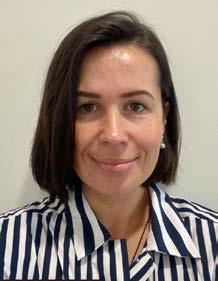

care the first few months, and we were airlifted from Wagga Wagga Base Hospital to the The Canberra Hospital. Here, we have received exceptional care, which in the meantime, inspired me to look at medicine as a possible future career.
When our first child was born, he required extensive medical care in the first few months… which inspired me to look at medicine as a possible future career. Sofiya, 31, first year
Becoming a medical student has been a big adjustment; going back to being unable to work full-time. Having little ones

at the same time presents an additional challenge. While I do have unconditional support of my husband, I wish there were more opportunities and extra scholarships available. We have moved the whole family with the plan to stay in Canberra for the junior years, and potentially during the training years, depending on program availabilities. Flexibility to a degree and consideration during rotations for the families with dependants would be good too.
Before studying medicine I worked in various education roles, including managing a year 12 boarding house, education design, directing a choir and teaching.
Working with children in several diverse contexts ignited a passion for youth mental health and highlighted many systemic inequities which drive adverse mental health outcomes. As I explored different ways to address these barriers, I realised that medicine would not only allow me to be directly involved in patient care but also provide opportunities to advocate for

meaningful social change.
Unfortunately, the concept of a salary in four years’ time does not pay today’s bills. The financial burden and opportunity cost of studying postgraduate medicine is not only shouldered by us, but also our friends and families.
I’ve been fortunate to have had steady employment prior to medicine, but with the rising cost of living the diet of rice and beans might not be fully behind me yet!
I’m likely to stay in Canberra as a junior doctor. I value the community of friends and colleagues I have met here (and love the lack of Sydney traffic). I would like to see CHS do more to show that staff psychological, physical, and financial wellbeing is a priority. This involves concrete frameworks for managing patient loads, rostering, out-of-hours work, reporting inappropriate behaviour, and so forth.
I did a Bachelor of Science (honours) at Monash in Melbourne, and then went directly into med school. The financial burden of studying medicine has been brutal. I live in a share house, which is
cheaper than living on campus. Even still, Canberra is an expensive place to live. Carcentric infrastructure increases costs from fuel and registration, but public transport for me is considerably out of the way. As a medical student you are always expected to perform at 100%, which makes it difficult to take time for self-care, and the cycle makes impostor syndrome very difficult to manage. Even still, the stress fosters a degree of camaraderie amongst your peers. Once I finish studying medicine, I’ll most likely return to Melbourne to be with my family. That social support is a big factor. I definitely feel like there are less opportunities in Canberra to meet likeminded people, especially for neurodivergent students.
Before medical school, I completed a Health Science degree at ANU. I’m fortunate to have family in Canberra and have lived in a flat behind my grandparents’ house since 2019 (minus a year of rural stream placement on the NSW South Coast last year).
While studying, I work two jobs – tutoring primary and early high
in his care, and meeting his incredible surgeon was the catalyst for my decision.
When it comes to making ends meet, Centrelink helps financially, but it’s not enough to live on, let alone save. Working while studying medicine is demanding, but I love both jobs, not least because they offer a refreshing contrast to placement and study.
After medical school, I will most likely move somewhere warmer. I have bad Raynaud’s, and winters here are always a struggle. I also love the beach and have family and church ties in Sydney.
Talia, 24, third year
school students and modelling for Victoria’s Models Canberra. Growing up, I never wanted to be a doctor—I distinctly remember joking that I’d rather be a janitor. That changed in Year 12 when my father needed spinal fusion surgery (secondary to spondylolisthesis/spondylosis).
Homeschooled by him from Year 8, I was deeply involved
All my tertiary study has been in Canberra, where I completed my Bachelor of Health Science at ANU. I moved straight from my undergrad into post-graduate medicine.
I initially lived on campus, but I’ve recently moved in with my partner off campus, and we rent a place in the city with a flatmate.
The financial burden of studying medicine is significant. While scrubs, Amboss, and my own
sphygmomanometer feel essential, I’m lucky that I have so much support around me that I don’t need to decide between essentials for study over affording rent or groceries. It is stressful not having the time I once did to work though – I had three jobs in undergrad, and now I work casually maybe a month a semester. It places a heavy feeling of guilt on me sometimes because of how little I feel I can contribute financially to my family. My best friend is definitely Centrelink. I’ve fallen in love with Canberra and while I wouldn’t mind staying once I finish my degree, my priority is my family back in Sydney. I’m hoping to be able to move back to NSW so I can be closer to them. Ultimately, a bigger city is better suited to both my partner and I. For CHS to be more attractive to junior doctors, I think it would need to offer more visible support services and more financial transparency. Additionally, more opportunities for junior doctors to pursue their ideal specialty – for example how OBGYN is

often left unaccredited, which is a large concern for junior doctors interested in pursuing that!
Lauren, 25, second year
Before studying medicine, I completed a Bachelor of Biomedical Science with Honours. I was fortunate to present my Honours research at
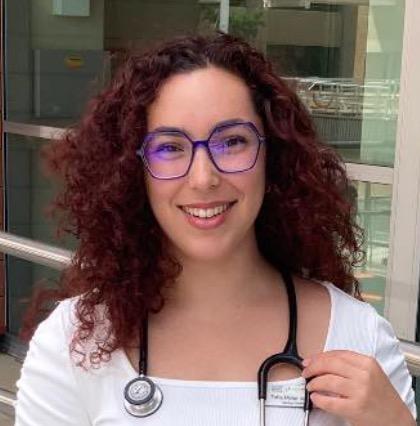

We are proud to announce that Canberra Region Neurology and Pain Centre (CRNPC) Day Hospital has successfully achieved full accreditation for the second time under the National Safety and Quality Health Service (NSQHS) Standards Australian Council on Healthcare Standards (ACHS).


years’ experience
State-of-the-Art Facilities
• Modern procedure room for interventional pain procedures
• Specialised infusion centre for advanced therapies
• Dedicated recovery area ensuring safe & comfortable patient care
Continued page 8
a few months while writing up my research into an article. When I returned, I worked and enrolled in a Bachelor of Paramedicine/ Bachelor of Nursing double degree, which I pursued for a year before being accepted into ANU. I live in a share house with two For CHS to be more attractive to junior doctors, I think it would need to offer more visible support services and more financial transparency.

Current services
• Consultations - neurology, chronic pain, neurosurgery
• Diagnostic services - Nerve conduction studies, EMG, EEG. Same day appointments available
• Botox treatments for extensive range of neurological and pain conditions
• Interventional pain procedures
• Infusion treatments
• Allied health
Expanding Services
• Currently specializing in interventional pain procedures with sedation
• Future expansion to include carpal tunnel surgery, endoscopic & dental procedures
• Utilising theatre facilities with option of sedation.
If you are interested in utilising the theatre facility or infusion centre, please contact us at reception@crneurologyandpain.com.au. We would love to arrange a meeting with you and work with you.
Continued from page 7
other med students, Hannah and Liv, and my beautiful husky, Bo. I work for Adult Retrieval Victoria, which is part of Ambulance Victoria and provides clinical coordination, retrieval, and critical care services. Since its a Victorian organisation, I can only do shifts when I return home, which can be difficult to coordinate. However, I really love working there and find it incredibly rewarding. I hope to one day work at ARV as a retrieval doctor as I admire the service we provide to the state, especially those living in rural areas.
Living out of home while studying full-time can be challenging, especially since my work is interstate and I have a dog who depends on me. During holidays, I work as much as possible and
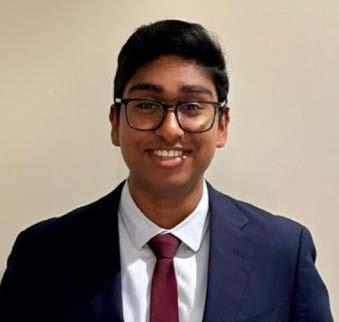
medicine. I currently live in a sharehouse, and work as a tutor in maths and science for high school students.
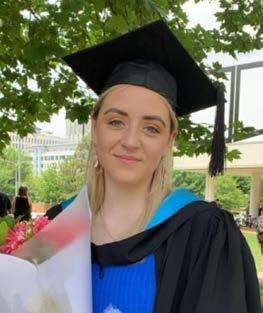
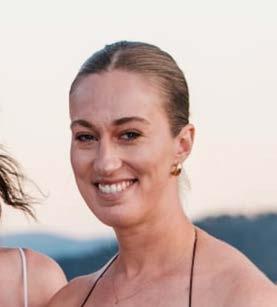


The financial burden and opportunity cost of studying postgraduate medicine is not only shouldered by us, but also our friends and families.
Catherine, 25, third year
save what I can. Fortunately, I receive government support, and my family is incredibly supportive, for which I’m very grateful.
I’ve heard that Canberra provides excellent support for junior doctors, and I like the idea of working with people I already know—whether they are my former teachers or peers from ANU. On the other hand, I have applied for and been accepted into the Rural Stream because I do have a keen interest in living and working rurally.
Navod, 21, second year
I did the Health Science undergraduate degree at ANU before enrolling in postgraduate
Completing postgraduate medicine takes time and a lot of money and I am extremely lucky to have my parents supporting me through my studies. That being said, it has become difficult. In recent years, expenses have skyrocketed, and it has become increasingly difficult for my parents to support my sister and I. If I was to afford popular external resources like AMBOSS or Osmosis it would set me back between $150 to $300 a year per service, which isn’t financially viable for me. Having lived in Canberra since 2021, I’ve grown to love the city. I’ve been able to fully settle here and grow my network of friends and colleagues and for that reason Canberra is high up on my list of places to work once I graduate. However, I do miss living in Melbourne and the rich culture I grew up with back at home. CHS could become a more attractive option for junior doctors by showing it is a safe working environment with good engagement and financial support. It is no secret that Canberra has had its fair share of bullying and harassment. Even before entering medical school I had heard of these stories. While there have been reports of this significantly improving, I think it is important for CHS to come out and ensure that its junior doctors, and other healthcare workers for that matter, feel trusted and engaged by their employees.
I grew up in Canberra, and have lived here my whole life, still living with my parents and siblings at home. Before medical school, I completed my Bachelor of Health Science at ANU.
I work at a Women’s Health and Fertility clinic, doing a mix of administrative and clinical work, including phlebotomy. I am heavily involved in cycle tracking for the fertility cycles, and I get to work closely with the doctors in our practice in the management of these. I also tutor two year 12 students in science and maths.
I’m fortunate to live at home and avoid rent, but balancing study with work is still tough. Medicine demands so many hours outside of class that finding a flexible job with decent pay is difficult. Some weeks, I feel like I have to choose between saving for the future and actually enjoying life outside of uni.
I think I’ll stay in Canberra for my junior doctor years. Living at home will help me save, and I’ve spent my whole life here – it’s home, at least for now. Professional connections are another big factor keeping me here in Canberra. That said, I see myself working elsewhere in the future, maybe in Northern Queensland or overseas. Cost of living and house prices will play a role – I can’t live with my parents forever but affording housing here is daunting.
As a medical student I wish I had more support on knowing what the pathway to different specialties looks like, and
also research pathways, especially at CHS. Finding the information is really difficult.
Straight after school I did a Bachelor of Science (Advanced Mathematics) at the University of Sydney then took a gap year to travel the world before moving to Canberra to study a Bachelor of Physiotherapy (Hons) in 2016. I then worked full time as a sports physiotherapist for two years before starting medicine at ANU. I live with my partner in a house that he owns with a mortgage. I am lucky enough to also have my own apartment in Canberra, which I bought with the help of my parents when I was working. I currently rent it out. Studying medicine wasn’t always the plan. Unfortunately my first year of working as a physiotherapist was during covid so my patient load was very light and I was very bored. I thought if there is any career that won’t be boring (especially during a pandemic) it is probably medicine. I had plenty of time on my hands to study for the GAMSAT so it worked out well. I am loving my clinical years at medical school and I have no regrets.
I’m very likely to stay in Canberra once I graduate as my partner and I are very settled and like it here. However, I am always open to an adventure. The decision would come down to what is best for my family and career goals, as well as factors like salary, work/life balance and career/training opportunities. I think some people, particularly
older generations, assume that medical students don’t have to worry about money and that we don’t have other responsibilities, which isn’t the case. Juggling so many things in life (study, work, family, relationships) is more stressful than the study itself.
Emily, 27, fourth year
I took three years off after high school for work and travel, and then started a Bachelor of Psychology at UNE (Armidale). I transferred halfway through to ANU and completed my undergrad there before beginning Medicine. I live in a share house and work as a Junior Doctor Advisor for AMA ACT and as a gym instructor. Balancing work and study is very challenging. In first and second year I maintained around 25 hours of work a week, but it impacted my wellbeing and grades significantly. In third year, I was lucky enough to be selected for a Rural Doctors Network Cadetship which includes a scholarship –but I will still be required to work. I try to protect my weekends, so I am often working, studying or at placement from 5am until late into the night each weekday. My scholarship includes a return of service in select rural hospitals, so I will not be staying in Canberra once I finish my degree. If I were not a Rural Doctors Network Cadet, I think that familiarity and relationships that I’d built over my time as a student in Canberra would make me think about staying. Internship is a huge adjustment, and I would look for a place that I would feel well supported.
Reuben and Courtney
Caudell met at ANU O-Week in 2021 and married at the end of second year. They are now both interns at The Canberra Hospital and are thinking through how to prioritise their relationship as they move forward in medicine.
Reuben:
I’m from Queensland originally, where I did my bachelor’s degree in biomedical science. I chose Canberra for medical school because ANU had a reputation for collegiality and mentorship. People described it as ‘cozy’ and ‘comfortable’, and that appealed to me.
I first got talking to Courtney at a coffee catch-up for Christian medical students during O-Week and we started dating soon after. Courtney and I have some shared hobbies like gaming, reading sci-fi books, and playing music – she plays violin much better than I play guitar. Right from the beginning our relationship was very public among the students. I think we were the source of gossip for about a year. Lots of couples form at the medical school, but I think we might be the first to have met and married while still studying. Our wedding was at Gold Creek Chapel and about a third of our year group came along, together with our family and friends from Queensland and New Zealand. Pretty much straight after that we moved to
Young for our rural rotations. It was nice to take a break from Canberra in a new location together, where people got to know us as a couple. We were both offered internships in a few places but decided to stay in Canberra because we didn’t quite feel we’d had enough time here. Canberra is such a great place to live, with a good food scene, plenty of festivals and the natural beauty of the mountains. We also love the community here, especially our church. It made sense for us to capitalise on the broad range of experience we can get at Canberra Hospital before we move elsewhere to specialise.
Long-term we would love to go rural or remote. We both went to Yuendumu in the Northern Territory as part of our rural year, and that was a highlight for both of us. Not only was it a very welcoming community, but the country was beautiful and the medicine was interesting.
Courtney and I have different strengths. She’s got great procedural skills and a lot of confidence with clinical work, whereas I prefer roles where you spend a lot of time talking to patients. When we think about our ‘top three’ specialties, mine are Paediatrics, Infectious Diseases and Psychiatry. Courtney’s are ED, Rural Generalism and Critical Care. Our priority when choosing jobs will be moving to the same location rather than necessarily getting the ideal positions. We’d like to find roles that are complementary.
I always say I’m half-Australian because growing up, my family moved back and forth between Western Australia

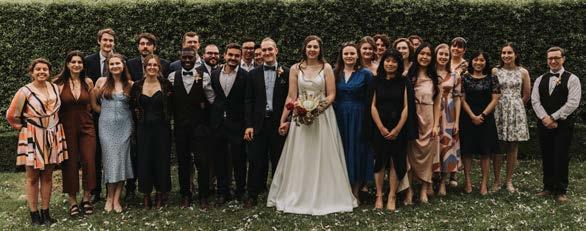
and New Zealand. After doing an undergraduate biology degree in New Zealand, I came to Canberra in 2021 for medical school.
It was quite funny when Reuben and I first started dating and we were still trying to keep our relationship under wraps. Whenever we wanted to go and spend time together on campus, we’d always bump into someone who knew us.
Throughout our degree we had virtually no classes together because our last names were on opposite sides of the alphabet. It became a running joke to see whether we would finally be put together for a block. It just never happened. We hung out after class, and it was fun to compare notes.
After dating for about a year, we decided we wanted to get married, but we both wanted the proposal to be a surprise. So Reuben organised a series of four mystery dates and told me he’d pop the question during one of them, but I wouldn’t know which one.
The first date was dinner. The second was a picnic lunch. The third was an early morning hot air balloon ride over the lake, followed by a walk around the beautiful Beijing Garden. It was there that Reuben got down on one knee and pulled out the ring. It was quiet something. Our fourth date was at a coffee shop, where we began planning the details of our wedding.
I appreciate the ways in which Reuben is different to me. He’s quite
good at talking to people, whereas I often feel quite shy. The two of us study differently and have different sets of knowledge. He’ll often teach me things I don’t know. At home, Reuben is good at setting aside time to relax, whereas I don’t think I’m as good at work-life balance.
During our engagement we talked a lot about how we can protect our marriage even as work gets demanding. We’re intentional about spending time together, like trying to have a date night every fortnight. We also love spending time together with our non-medical friends, who help us to get outside the medical bubble. At the end of the day, we both want our marriage to be more important than our careers.
Medical Benevollent Association of NSW-ACT
Since 1896, doctors’ wellbeing has been the core of MBA NSW-ACT’s mission. Our long history means we understand the unique and varied challenges that medical practitioners face. Our experienced specialised social workers can guide you through life’s challenges, whether the adversity is personal or professional.
For assessment, counselling, information, and advocacy


MBA can provide limited funds during times of financial hardship.
Our support is strictly confidential, free, and independent of the regulators. Please call 02 9987 0504 (Option 1) if you are facing an issue that is causing distress or if you want to explore options for a colleague. We are available Monday – Friday between 9am and 5pm and can schedule after hours appointments. You can elect to remain anonymous.
Help Us Help Others: If you don’t need our help now, please consider supporting our charity to continue this vital work, by making a tax-deductible donation.
Commission for an Intractable Bargaining Declaration, with support from AMA ACT.
Intractable Bargaining Declarations are a new feature of industrial relations law, commencing in June 2023. The Commission will evaluate the merits of the case, as well as factors including the interests of the employers, employees and the public. It will then hand down its binding determination which will effectively become the new Medical Practitioners Enterprise Agreement.
stretching back to early 2023.
Several individual doctors have prepared evidence to present to the Commission, highlighting the human impact of unfair wages on ACT’s public hospital doctors.
One such doctor, an intern paid $77,898 annually, described how she was only able to live on her wage and support her family because of her husband’s income.
“The present pay conditions are hopeless,” she said in her submission, detailing the sacrifices she and her family are forced to make because of her work at the hospital.
Although there is no deadline, AMA ACT expects the matter will be resolved within three months. The determination is likely to include back-payments
Another, a registrar paid $112,917 annually, has provided evidence detailing how his childcare expenses, mortgage repayments, HECs debt and registration fees have increased over time but not his wages. He described how low wage growth made it hard to recruit doctors to work in Canberra’s public hospitals, compounding stress on existing staff.
The ACT Government has
not provided any substantive reasons as to why AMA ACT’s wage claim is unreasonable. Instead, it has argued that its proposed pay increase is comparable to the last two Medical Practitioner Enterprise Agreements. It has also noted
that doctors receive a range of other financial benefits extending beyond their base salary.
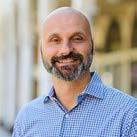
psychology
Health anxiety is a common yet complex issue in our community. Sometimes referred to as “the worried well”, these individuals experience persistent and excessive worry about having or developing a serious illness, even in the presence of medical reassurance and little to
no physical symptoms.
Heightened awareness of bodily sensations can result in frequent medical consultations, repeated diagnostic requests, and difficulty accepting negative test results.
GPs play a vital role in helping patients disrupt the cycle of health anxiety. By addressing the underlying cognitive and emotional components rather than focusing on reducing physical symptoms alone, it’s possible to help patients come to terms with their discomfort, ultimately leading to better wellbeing.
The following strategies from psychology may help.
1) Validate and psychoeducate
– Recognise the patient’s distress and provide education about the connection between the mind and body. Explain that anxiety can manifest as physical
symptoms, reinforcing their fears.
2) Manage reassuranceseeking behaviours – While frequent reassurance may seem helpful, excessive medical testing can reinforce anxiety. Establish clear boundaries regarding investigations and emphasise functional wellbeing over disease exclusion.
3) Try cognitive and behavioural strategies – Help patients identify and challenge catastrophic health-related thoughts. Gradual exposure to uncertainty and distress tolerance techniques can support symptom management.
4) Refer to psychological services – For persistent cases, consider referring patients to a psychologist for structured therapy, such as Cognitive Behavioural Therapy (CBT) or Acceptance and Commitment Therapy (ACT) which both have strong empirical support for treating health anxiety.
Supporting you to ensure your rights are protected, no matter what career stage you are in.
• Public hospital matters
• Negotiations and determinations
• Performance management
• Bullying and harassment
• Contract checking service
• Unfair dismissals and workplace investigations
• Practice management support ama.com.au/join

Email industrial@ama-act.com.au
Phone (02) 6270 5418
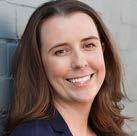
DR DANIELLE MCMULLEN
President
Prime Minister Anthony Albanese kicked off Labor’s 2025 election campaign in February with a commitment of $8.5 billion for Medicare and general practice — the largest funding announcement since Medicare began.
I welcome the announcement and the Coalition's commitment to match the government's pledge. This bipartisan recognition of the need for significant investment in primary care is pleasing to see, and follows years of campaigning by the AMA. This shows that both sides of politics understand the
funding that's needed to reverse decades of underinvestment, improving the sustainability and affordability of general practice. We know patients have been delaying care due to cost and that saddens me. We urgently need investment and reform to turn that around.
The announcements will do part of that – improving sustainability of our most vulnerable practices, and perhaps allowing some practices who have recently commenced charging a private fee to return to bulk billing. But it won't improve things for everyone, and many patients will still face out of pocket fees - for many practices even the additional incentive doesn't meet their costs.
We still have work ahead. We need solutions that help everyone.
With increasing rates of chronic disease, mental illness, and an ageing population, Australians need more time with their GP.
While this announcement helps affordability for vulnerable Australians, we must push for a Medicare that better funds longer consultations for everyone. I don't mean just those over 40 minutes...but we all
know that a lot more can be achieved in 18 minutes than in 10. At the moment patients only have the same rebate for those two consultations. Medicare needs reform.
We need to address the fact that the actual MBS rebates have fallen far behind the cost and workflow of delivering high quality, general practice care to the community.
AMA's plan to Modernise Medicare at modernisemedicare.com. au lays out a platform for change; tangible steps we can take to improve access to care for all Australians. Lastly, I must say I'm super excited about the workforce initiatives announced: more training places for GPs and early career doctors considering a GP specialty. Sign-on bonuses, and paid parental and study leave for GP trainees to help reduce the disparity with hospital colleagues. These are changes the AMA has long advocated for to address critical shortages.
As the election approaches, I look forward to all parties' plans for sustainable general practice
The maternal RSV vaccine (Abrysvo) is now free under the National Immunisation Program (NIP) for women at 28–36 weeks pregnancy.
Australian Government Chief Medical Officer, Professor Anthony Lawler noted RSV vaccination is particularly important in pregnancy, reducing the risk of severe RSV illness in infants under 6 months of age by around 70%.
The maternal RSV vaccine can be co-administered with pertussis and influenza vaccines.
Meanwhile, from 17 March the ACT Government will offer the RSV immunisation product Beyfortus to eligible infants before discharge from hospital. This includes infants not protected by antenatal RSV vaccination and infants at increased risk of severe RSV disease, regardless of antenatal vaccination status.
Canberra Health Services will also facilitate catch-up programs to provide Beyfortus to vulnerable babies born before 17 March 2025.
To read the eligibility criteria visit www. act.gov.au/health/topics/diseases/ respiratory-syncytial-virus-rsv
What Labor and the Coalition are promising:
A new incentive payment from 1 November for practices that bulk bill every patient
Fully bulk billing practices will also receive an additional 12.5% loading payment on their Medicare rebates
Extra 200 GP training places per year from 2026, and 400 from 2028
$204.8 million for salary incentives for junior doctors to specialise in general practice
Paid parental leave and study leave for trainee GPs
Extra 200 rotations in primary care per year from 2026 and extra 400 from 2028
care for all Australians. We will keep fighting for the reforms our system needs across general
What the AMA is calling for through our Modernise Medicare campaign:
A new seven-tier standard consultation item structure for general practice
An extra 500 prevocational training rotations in general practice
An additional 500 GP training places
Fairer pay and leave entitlements for GP trainees
Support to employ more nurses and allied health professionals in general practice
To find out more about the campaign visit modernisemedicare. com.au
practice, public and private hospitals to ensure Australians get the best possible care.
Canberra Hospital will now only accept specialist led outpatient external referrals by eReferral.
The change came into effect on 1 February 2025, and means external providers need to use the HealthLink interface to submit eReferrals. Faxed, email or postal referrals for specialist services will no longer be accepted. If a referral is received outside of the HealthLink eReferral process, it will not be registered in DHR, nor viewed by our specialist team. Canberra Health Services says in such cases, Central Health Intake will notify the referrer that
the referral will not be registered. CHS says it will transition all services to accepting eReferrals at all referralbased services and CHS facilities by 30th June 2025. It says support and education will be provided to referrers that have not previously used HealthLink eReferral.
For more information visit the HealthLink website at www. healthlink.com.au/nswhealth/resources/ or email Rebecca.Millar@act.gov.au

As a former Olympic swimmer, Dr Rachel Harris is passionate about helping female athletes understand their physiology and work with it, rather than against it.
“You think of athletes as being really in tune with their bodies, but often that’s not the case,” she says.
Dr Harris recalls that many of the swimmers she raced alongside as a teenager were placed
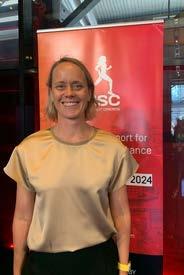
on hormonal contraceptives without knowing why. “It was just the thing everybody did.”
“No one helped us understand how our bodies worked or spoke with us about the impacts of hormonal contraception, which can affect thermoregulation, endurance and power.”
These days, Dr Harris is pleased to be regularly speaking with female athletes about issues like periods and infertility.
In addition to being the Chief Medical Officer for Swimming Australia and working in private practice three days a week, Dr Harris leads the Female Performance & Health Initiative at the Australian Institute of Sport (AIS).
“My role at the AIS is to educate female athletes, together with their parents, coaches, medical and support staff, about how female bodies work and to improve their health literacy around commonly misunderstood issues,” she says.
“It’s a constant uphill battle with so much misinformation on Tik Tok and other social medial platforms.”
So what are the most commonly misunderstood issues? Here’s what Dr Harris had to say:
There’s long been an idea that it’s normal for female athletes to lose their period. It’s not at all normal. It can have huge health implications, impacting bone turnover, illness and fertility. Putting the athlete onto an oral contraceptive pill is not the answer; it just masks the issue. The absolute primary goal for managing amenorrhea associated with exercising is restoring the normal menstrual cycle, which is usually achievable. It requires working with the athlete and their team to either reduce the amount of energy they’re expending or enable them to fuel their body better.
2. Pelvic floor dysfunction is not normal
Pelvic floor dysfunction is incredibly common in athletes, especially in gymnastics sports, snow and contact sports. It’s worth getting a baseline understanding from anyone who is involved in athletic sports about how often they might

have urinary or bowel leakage. The problem affects athletes at every life stage, including those as young as 11 or 12. While incontinence has been seen as taboo for a long time, we need to talk about it and get these athletes connected with women’s health physios early.
3. The biological clock is real
Fertility and pregnancy is a huge
issue with the rise of women’s professional sport. It’s vital that medical and coaching staff learn how to safely manage athletes through pregnancy and their post-partum period, and ensure sports support them through this life stage. We also need to be encouraging our athletes to start to think about the biological clock early on in their career so we can assist them to make empowered choices about their fertility.
FPHI have developed a range education modules, including one specifically for medical practitioners. For more information go to www.ais.gov.au/fphi
Dr Abigail Ng, radiologist
Canberra local, Dr Abigail Ng, recently started a new position at I-MED Radiology in Canberra. Dr Ng is a Consultant Radiologist
with subspecialty interests in Neuroradiology, Musculoskeletal, and Chest Radiology.
Dr Ng earned a Bachelor of Medical Sciences (First Class Honours) from the International Medical University (IMU), Malaysia, in
2014, followed by a Doctor of Medicine and Surgery from the Australian National University (ANU) in 2016. She also completed a Graduate Diploma of Anatomy at Macquarie University in 2018. Beyond medicine, Dr Ng enjoys
Are you new in town? Or has your practise welcomed a new doctor? We’d love to help you get the word out to referring doctors by running a profile in the next edition of Canberra Doctor. It’s easy – just scan the QR code.
floral arranging and travel.
Dr Ng is working across all four Canberra I-MED clinics located at Deakin, Belconnen, Woden and Tuggeranong. For more information visit: i-med.com.au

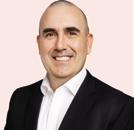
a medical practice comes with a range of challenges and an ever-present exposure to risks. These risks threaten your financial security and practice viability.
At any one time, medical practices and practitioners can face a number of potential
liabilities, which may have significant financial and reputational consequences. These include everything from malpractice claims to property damage and even theft. It's critical to have a well-thoughtout risk management strategy as underinsurance can place your practice at risk. Let's take a look at the three key areas that need your focus now:
Insurance costs are escalating; now more than ever it’s important to understand policies in place
and what your practice is covered for. In over 50% of reviews, we complete for practices we uncover over-insurance; there may be better ways to manage your policies and align them to your specific practice needs.
Cyber insurance is the fastest growing claims type within Australia. In today's digital world, healthcare businesses are increasingly vulnerable to data breaches and cyberattacks. Cyber liability insurance helps
cover the costs associated with data breaches, including legal expenses, notification and credit monitoring services and potential liability for compromised patient information.
Medical practices are at risk of being sued by patients if they believe a healthcare professional has provided substandard care or has been negligent in their treatment, resulting in harm or injury. This cover helps to protect healthcare professionals
Editor,
I advise against a blanket adoption of yet another IT technology. AI is easily capable of controlling our personal consultation styles. AI should be carefully examined in actual practice and should never be forced upon a clinician in the way that all other IT has been.
As a poet, it is language that concerns me. It seems that if you speak during the consultation on any subject, including those extraneous to the consultation, AI will record you. Then you have to go back and edit.
I think that as a doctor uses this iteration of AI, they will quickly tire of editing, and, subconsciously or not, reduce what they say in
the consultation. No more little chats or enquiries about others in the family; heading off patient’s anecdotes. Eventually personality will be quashed, they will be speaking to the AI and not the patient, and finally all consultations will become mere templates… ultimately delivered by AI itself.
A second consideration for anything that purports to save your time is what will be done with that time? AI could lead to a push to doing more consultations, which is unhealthy for many of us.
My college, ACRRM, requires ‘cultural safety’ in a number of areas: but AI is not on the list, though it is capable of rapidly destroying clinical medicine as
we know it today. That is, our culture: that of the fundamental humanity of our time-honoured medical profession, expressed through skilful and empathic communication with verbal and body language.
We should ask ourselves who is this all for? You? The patient? The managers? The lawyers? The cloud? How do you know, after last year’s MediSecure hack, you are not subject to surveillance? And by whom?
I am not saying that AI is intentionally designed to control us, but at the same time we must be alert to expert corporate manipulation. We have after all just passed legislation to deter the
from claims related to errors, omissions, or negligence in providing their services. It can cover legal defence costs, settlements, and judgments.
So, are you at risk or do you have the right cover?
If you are unsure and want guidance in navigating your insurance needs speak to one of our advisors today on 1800 988 522 or contact us via generalinsurance @cutcher.com.au
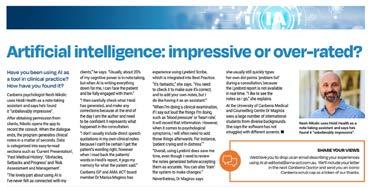
psychological damage caused by social media.
AI should not intrude into the crucial doctor-patient relationship: its priorities should never be
allowed to predominate in face-toface medicine.
Sincerely
Tim Metcalf, GP Calwell Centre.
Canberra psychiatrist Dr Fatma Lowden has been making regular aid trips to her former homeland Türkiye since a devastating earthquake in February 2023 killed more than 50,000 people and displaced millions. Now two years on, Dr Lowden says her most recent visit in October 2024 left her discouraged at how much aid efforts have stalled.


“Across the affected region over 650,000 people are still living in containers,” she says. “Despite this, much of the volunteer activity has stopped, a lot of the outreach services have stopped and sadly, a lot of the aid doesn’t reach the people who need it due to challenges such as logistics.”
Dr Lowden lost three loved ones in the 6 February earthquake and was grief stricken for her country, where she received her initial education in medicine and psychiatry, before retraining in Australia.
“I could not sit and watch on the media what was happening,”
Dr Lowden says. “I closed my consulting room for six weeks to go and help.”
Dr Lowden boarded the first plane she could, arriving in Antakya (Antioch) on the ninth day of the disaster to join other volunteering psychiatrists from Istanbul.
In those early days, Dr Lowden was part of work conducting field surveys in several affected cities to identify needs. She helped establish adult and child psychiatry outpatient clinics and began seeing patients through those clinics, as well as through mobile teams which visited remote areas. She provided training to other volunteer psychiatrists, psychologists and social workers, as well as translation services and psychological support to mental health workers in distress.
One project close to Dr Lowden’s heart was the establishment of a Psychosocial Therapy Centre at Adiyaman. Planning for the service commenced soon after the earthquake, and by June 2023, a building had been erected. By October a childcare centre had been added next door. Outside
of the time she spent seeing patients, Dr Lowden did what she could to support the centre, including tidying the school room for the children’s arrival. However, she said she was disappointed at her last visit to find the centre had struggled to provide services due to significant funding problems. Over several visits, Dr Lowden has observed increasing domestic violence in tent cities and container cities, and says women and children are very much affected. “Many of them live in fear,” she says.
A few moments stand out for Dr Lowden. One was on 20 February 2023, when a magnitude 6.4 earthquake struck the hospital where she was working and it collapsed. “I’m lucky to be alive,” Dr Lowden says. “I only just escaped by crawling out. Our accommodation was destroyed and so we had to stay in a container.”
Another moment Dr Lowden won’t forget was providing group trauma therapy sessions to Syrian female refugees with the help of a translator.
“Due to the existing tensions between Turkish and Syrian people, usually the groups started off with a bit of disinterest from the refugees, however within 1015 minutes of the session, most of them were silently weeping. By the end, almost all were talking to me in Arabic as if I was one of them, with a sense of real connection.”
While Dr Lowden’s visits have come at significant personal financial and psychological cost, she says



she plans to keep returning.
“Being a part of the earthquake response has significantly changed my priorities,” Dr Lowden says. “I feel more grounded, appreciating
what I’ve got here in Australia.”
“This is the most rewarding thing I’ve ever done in my professional life,” she adds. “I’ve learnt what I’m made of.”
If readers would like find out more about how to help the ongoing aid work in Türkiye, please contact Dr Fatma Lowden at fatma_lowden@hotmail.com
Ahpra has introduced a raft of measures to introduce equity into registration fees for practitioners on extended leave due to legally protected attributes, such as parental or carer responsibilities and disability.
The measures were announced in December, and include a 30% retrospective rebate on annual registration fees for practitioners who take parental leave, effective 1 July 2025.
Ahpra also said it was improving the current processes when transitioning between practising and non-practising registration, including capping the annual cost to those transferring within a registration year.
It also promised a review to look at
a wider pro-rata approach to fees, with a report expected by November and recommendations aimed at coming into effect by 1 July 2026. The reforms are a testament to the collective advocacy efforts of AMA, its members, and supporters.
AMA Victoria has led a concerted campaign for fairer registration fees, with doctors around the country joining its petition.
Dr Jill Tomlinson, President of AMA Victoria emphasised that the
measures represent only a first step.
“The 30% retrospective rebate, though acknowledged as an interim measure, is not an appropriate long-term solution,” she said.
“Consideration of practitioner income levels would deliver a more equitable approach, and a more fulsome achievement in embedding the principles of equity and providing for a flexible workforce.”
Dr Tomlinson said Ahpra must now prioritise developing the capability to
implement pro-rata fees, commit to this as a long-term goal, and provide a clear implementation timeline.
“Ahpra’s recognition of the importance of equity in its fee structures is a promising start,” she said. “However, equity must be embedded more deeply, and pro rata fees must become the standard.
Non-practising registration must also be reformed to better meet the needs of practitioners taking temporary leave.”

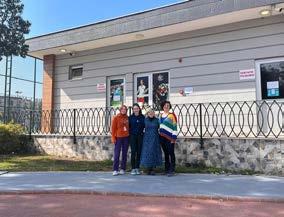


Dr Kerrie Aust sends shout outs to:
Dr Anne-Marie Svoboda, GP Liaison at The Canberra Hospital “for the tireless work that she and the team do to reduce the administrative burden on GPs, by helping us to follow-up results, and by advocating for patients in the hospital.”
Dr Andrew McMahon sends shout outs to:
Dr Sarah Gardner, gastroenterologist at The Canberra Hospital for “not shying away from challenging patients and being an excellent example of providing medical leadership in a multi-specialty/multi-disciplinary team environment.”
Dr Phil Keightley, consult liaison psychiatrist at The Canberra Hospital, for “always being willing to engage in a collaborative discussion over mutual complex pain patients and for continuing to provide ongoing consult liaison support, even when the patient isn't at a stage of change to fully engage with psychology yet”.
Know a colleague who deserves a shout out for going above and beyond? Email their name and why you’re nominating them to editorial@ama-act.com.au and we’ll include your message in our next edition.
We are excited to announce the opening of our two newest collection centres.
Gungahlin Marketplace Shops 27-28, Ground Floor
Open Mon-Fri 7am-6pm Sat 7.30am to 1.30pm
Casey Shop 1, Casey Market Town Open Mon-Fri 7am-3pm

From 28 February to 10 March 2025, the Enlighten Festival returns to celebrate Canberra’s role in “Reflecting Our Story” — the telling, sharing, holding, and writing of our country’s stories. The festival’s iconic projections in the National Triangle will once again transform the city with dazzling
displays of light and art. For those eager to explore further, Enlighten: The Night Shift offers a diverse range of experiences across the city, inviting visitors to immerse themselves in the festival spirit, and experience the city’s iconic institutions like never before.
Located in the open-air surrounds


of the Senate Rose Garden, Lights! Canberra! Action! shines a spotlight on local filmmaking talent on Friday March 7 with this short film festival. The 2025 theme is ‘Looking Back, Looking Forward’.
One of the highlights of the Enlighten Festival, Symphony in the Park will see Melbourne soul and funk band, The Bamboos, take to the stage with the Canberra Symphony Orchestra to deliver a stunning performance under the stars on 9 March 2025. This free event promises an evening of great music, energy, and community in the heart of the city at Commonwealth Park.
Celebrate the city’s birthday and support your community by joining the Canberra Day Appeal Fun Run on Canberra Day, 10 March 2025. With 2.5km, 5km, and 10km routes, the run offers options for participants of all fitness levels, and profits from entry fees will go to Hands Across Canberra The 2.5km route is perfect for families and will offer a range of activities along the route, while the 5km and 10km will test the more


Canberra will come alive with a series of unforgettable events this autumn, celebrating the city’s culture, creativity, and community spirit.

serious runners. After the run, head to Commonwealth Park to continue thecelebration with markets, food vendors, and entertainment from 7:30am to 11:30am.
The Canberra Balloon Spectacular is set to soar to new heights from 15 to 23 March 2025. For the first time since 2018, this iconic event will be a stand-alone spectacle, with hot air balloons launching daily from the new location of John Dunmore Lang Place. Start your day with a magical sight as the skies fill with vibrant colours and shapes, including the special
balloons
This cherished event promises awe and inspiration for all ages and is well worth the early wake-up.
For more information visit events. canberra.com or head to the Events ACT social channels to stay up to date on all the events.
GIVEAWAY!
Send us a photo you’ve taken that captures why you love Canberra and we’ll send you an iconic Canberra scrub cap, courtesy of AMA ACT and Drs4Drs ACT. editorial@ama-act.com.au
The AMA has launched a new online interactive tool to help doctors-intraining (DiTs) make sense of complex enterprise bargaining agreements (EBAs) across the country.
The National Employment Conditions Comparison Tool — AMA neXt — provides DiTs with an easy-to-understand snapshot of important rights and working conditions such as salary, base hours, penalty rates and leave entitlements in the public health sector in each state and territory.
AMA President Dr Danielle McMullen said AMA neXt would help DiTs cut through the weeds of EBAs, which are notoriously complex and difficult to find.
“AMA neXt can help doctors-intraining at a pivotal and stressful time of their lives, when they are
wondering where the best place is for them to advance their medical career,” Dr McMullen said.
“The AMA is a strong advocate for ensuring doctors-in-training in public hospitals have access to fair and equitable working conditions, no matter where they work in Australia.
“EBAs are inconsistent in each state and territory and are often hard to understand, leading to stress and potential confusion among doctors-in-training about what their rights are.”
AMA neXt allows users to make simple side-by-side comparisons of employment conditions in each jurisdiction.
AMA Council of Doctors in Training Chair Dr Sanjay Hettige said AMA neXt could help DiTs to better understand their collective rights, leading to more opportunities for advocacy.
“Not only will this tool help doctors-in-training understand
AMA neXt can help doctors-intraining at a pivotal and stressful time of their lives
Dr Danielle McMullen
their rights at a glance, but it will also spark discussions about employment conditions for public hospital doctors across the country,” Dr Hettige said.
“Countless surveys — including many of the Hospital Health Check reports released by state AMAs and the Australian Salaried Medical Officers’ Federation — have shown

doctors-in-training often feel unsafe and fatigued at work in Australia.
“The AMA’s Specialist Trainee Experience Health Check also consistently uncovers issues relating to unpaid overtime and a lack of support for doctors-in-training.
“It can be daunting navigating complex EBAs, but we hope AMA neXt can help doctors-in-training
along their journey, while also highlighting the critical importance of safe employment conditions.”
AMA neXt is currently open to all users. It can be accessed at ama.com. au/resources/ama-next
AMA ACT’s annual Graduation Breakfast in December was a wonderful morning of celebration with ANU School of Medicine and Psychology’s class of 2024.
April Thompson (pictured below) won the Lucky Door prize, courtesy of Canberra BMW, which included a BMW for the weekend and lunch at Four Winds Vineyard.
It was a big week for Ms Thompson, who the previous
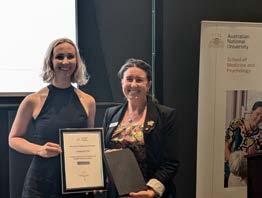
evening was awarded AMA ACT’s annual Student Leadership Prize, in recognition of her advocacy work and dedication to improving the experiences of her peers at medical school.

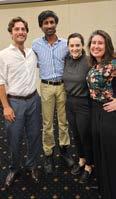



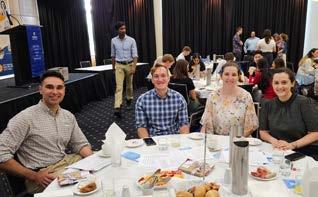
BY ZACH BILES
First year medical student, ANU
With free lunches, medical insurance registration and countless reminders that the next four years “will be hard” (who would have thought?), an actionpacked O-week schedule welcomed my cohort with open arms.
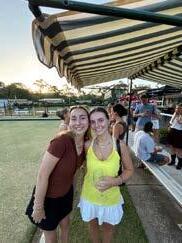
The festivities began with a Welcome to Country and smoking ceremony performed by Ngambri man Uncle Paul House, and those new to the Canberra region were fortunate to learn about the history of our new home.
Following an introduction to the
about self-care, the cohort made our way to the pub to practice the best form of self-care possible: trivia run by the General Practice Students Network. Friends were made along the way, with students coming together from all areas of the world including Portugal, Goulburn and of course, the Bush Capital.

RUC, Thursday kicked off with the first lectures in anatomy and histology, only to be topped off by a stellar evening at Llewellyn Hall with the AMA. Ever grateful for the time they donated to us; the cardiologists, emergency doctors, general practitioners, pathologists and even the health minister were put to the test, swamped by incredibly keen

4-day old medical students.
As the content ramped up on the final day, the week culminated in a wholesome picnic at Black Mountain Peninsula with our second-year buddies. On behalf of my cohort, I would like to say thank you for all those involved in making O-week such an informative, engaging and beneficial experience.

A News Magazine for all Doctors in the Canberra Region
ISSN 13118X25
All electoral matter in this edition of Canberra Doctor is authorised by Peter Somerville on behalf of the Australian Medical Association (ACT) Ltd.
Published by the Australian Medical Association ACT Ltd
Level 1, 39 Brisbane Ave, Barton ACT 2600 (PO Box 560, Curtin ACT 2605)
Editorial Sarah Colyer sarah-colyer@ama-act.com.au
Design Angela Wood reception@ama-act.com.au
Advertising Ph 6270 5410 Fax 6273 0455 reception@ama-act.com.au
Contributions
Canberra Doctor welcomes reader contributions. Submit your stories to editorial@ama-act.com.au
For more news
Visit ama.com.au/act
Follow us: bit.ly/amaactlinkedin /amaactbranch @AMA_ACT @amaact
Spread the word about your event, practice or organisation
Contact us to receive a copy of our Advertising Kit: reception@ama-act.com.au
Disclaimer
The more things change, the more they stay the same. That’s what longtime AMA ACT member, Dr Peter French, thought recently, when he stumbled across a set of 1948 cartoons (pictured) depicting some all too familiar challenges in medicine.
In the first frame, a woman asks her husband for money to buy a hat, but he says she’ll have to wait until he’s paid “the lodges” – the membership organisations through which many Australians once accessed primary care.
In the next frame, the woman tells her husband to visit the lodge doctor for his flu symptoms, but dear Herbert refuses, saying it’s a waste of time and claiming castor oil will cure him.
The cartoons were published on page 2 of Melbourne newspaper, The Sun, on May 26, 1948.
Dr French reflected: “The cartoon shows that nothing has changed in medicine; there have always been other gifted experts, who are only too willing to lend their opinion to anyone who will listen, to help solve medical problems, even if they have no training in medicine, such as the gentleman's boss,
who suggested ‘snake oil’ type treatment rather than seeing his doctor.
“Now, in the modern era, we have the added problem of not only local ill-informed experts, but also 'Dr Google’. Patients will often show up with reams of paper, with information of often dubious quality, that they have downloaded from the internet, expecting the doctor to read all of this in the next 5-10 minutes, during the consultation. The patient is not here for diagnosis; they’ve already made the diagnosis using all the information/misinformation and are just here to tell the doctor what the diagnosis actually is and what the doctor needs to prescribe for them.”
Outside of his work as a cardiologist and lecturer at the ANU medical school, Dr French has drawn many cartoons himself over the years, including several which have featured in the pages of Canberra Doctor.
One such cartoon (pictured) shows Mary and Joseph being turned away from an Obstetrics department because there were “no beds”. A funny idea, except for the fact it’s just as relevant today as it was three decades ago when Dr French drew it.
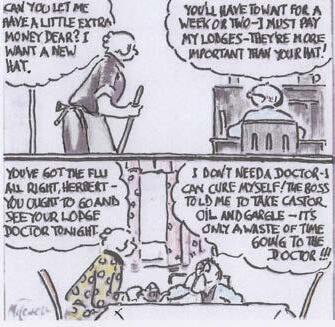


and which suffered from Bright’s disease?
and which had a retained bullet in the chest wall? … and which had multiple strokes?
… and which had polio?
What were the four humours of the body first described by Greek physician Galen?
Name at least one of the medieval medical uses for leeches.
What is the ANU using leeches for now?
Match these organisations with the year in which they were founded: RACGP, RACS, RACP, RANZCOG. 1936, 1998, 1958, 1927.
What nationality was the famous physician, missionary and explorer Dr David Livingston?
Find the answers on page 13






